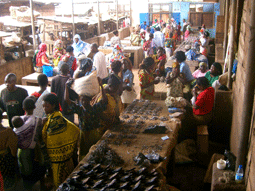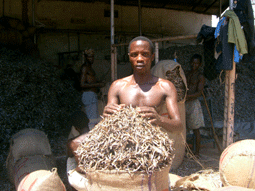 |

The Disappearing Sardines
by Jori Lewis

Fish halls of Mwanga Market, Kigoma. Photo: Kate Cheney Davidson
The area around Tanganyika is like a one-factory town, except there's no factory. There's only the lake: 420 miles long, nearly a mile deep, and with seemingly enough fish in its depths to support the more than 10 million people living on its shores.
Although there are over 300 species of fish in the lake, only dagaa shows up on the tables of even the poorest people. Only dagaa directly provides jobs to at least a million people in a place where there isn't much work. And only dagaa swims in the lake in such abundance. Dagaa feeds the nation, and the nation is growing. In Kigoma, the poorest region of one of the poorest countries in Africa, dagaa is essential.
Fishing in these parts follows the path of the moon. When the moon is not full, they go out into the open waters in search of a good place to catch dagaa, the silvery wonder the length of an index finger. The fishermen use kerosene lamps to attract zooplankton, dagaa's main food. It's a classic mouse trap. Lure the zooplankton and the dagaa will follow. And the darker the night, the more they are all seduced by the lights above. So, dagaa fishermen float on the waters of Africa's deepest lake all night, waiting.

Worker Issa Athumani packing dried dagaa to ship to the Congo. Photo: Kate Cheney Davidson
"You see in the night when the fishing is taking place. You see, you know… a big city with a lot of lights. Like maybe New York. It's a comparison. But it's actually fishermen who are actually fishing," says Hudson Nkotagu, a geologist at the University of Dar es Salaam who has spent a lifetime studying the lake. He says Lake Tanganyika is threatened by several factors. "Pollution is coming from various sources. Excessive fishing and also use of inappropriate use of fishing gear. Now, another threat that is coming up recently is the climate change."
"There's really no question the lake has warmed up. 0.8 degrees Celsius over the past 80 years," says Bard College biologist Catherine O'Reilly. She has been studying the lake's ecosystem for over a decade. In 2003, her article in the scientific journal Nature showed that a warming trend in the region is affecting algae in the lake. This development may be putting the dagaa population at risk in a place where this little fish is the biggest thing going. "So we see fewer algae, and the algae are growing slower than they used to, so that suggests that there's not as strong a base for the fish food web as there used to be. All the data that we have available to us right now - including the fish catch data, the climate data - all of that data points towards decreased fish populations."
Some fishermen are saying that over time their dagaa catches have gone down. Retired dagaa fisherman Myonge Seph fixes the cracks in his sons' boats by patiently pounding in bits of cotton dipped in bright yellow palm oil. He says dagaa fishing is certainly not as good as it was 30 years ago when he was first starting out.

Myonge Seph (center with hat) surrounded by local children at Kalalangabo. Photo: Kate Cheney Davidson
"Oh, it was so good. When we used to fish with our fathers, it was really good," says Seph. "There were so many dagaa. People could fish 5,000 tons. In tons! Back in those days there was so much dagaa."
Seph, a wiry man of 46, knows the moods of Lake Tanganyika. He knows, for instance, that there are at least four different types of winds that blow on the lake and that the big ones come when the corn has babies. That wind starts the time of scarce dagaa. Seph knows the routine well after a lifetime on the lake. It has its ups and downs.
"We fish because we have no other job," says Seph. "Our grandfathers fished here. Our fathers fished here. We'll fish here and pass it on to our children who will fish and pass it on again. It's our legacy."
Most fishermen say it's impossible for the dagaa to ever permanently go away. They know there are periods of plenty and periods of scarcity. During the periods of scarcity, the lake's lights darken.
The fishermen say the dagaa always come back. They always have before, and most people can't imagine that this cycle could ever break down. But this deep and ancient lake is changing, and not everyone will be able to change with it.
See a slideshow of the effects of climate change in Bangladesh.
Back to Reports from a Warming Planet